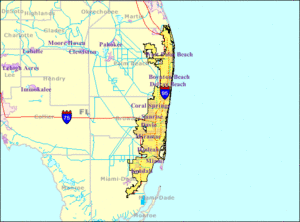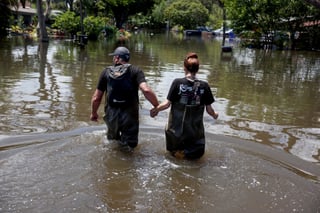The Miami metropolitan area (also known as Greater Miami, the Tri-County Area, South Florida, or the Gold Coast) is the ninth largest metropolitan statistical area in the United States and the 34th-largest metropolitan area in the world with a 2020 population of 6.138 million people. With 1,279.2 sq mi (3,313 km2) of urban landmass, the Miami metropolitan area also is one of the most populous urban agglomerations in the world. The City of Miami is the financial and cultural core of the metropolis. The metropolitan area includes Miami-Dade, Broward, and Palm Beach counties, which rank as the first, second, and third most populous counties in Florida. Miami-Dade, with 2,716,940 people in 2019, is the seventh most populous county in the United States. As defined by the Office of Management and Budget, the metropolitan area's principal cities include Miami, Fort Lauderdale, Pompano Beach, West Palm Beach, Boca Raton, Sunrise, Miami Beach, Deerfield Beach, Kendall, Boynton Beach, Delray Beach, Jupiter, Doral, Palm Beach Gardens, Wellington, and Coral Gables. The Miami metropolitan area sits within the South Florida region, which includes the Everglades and the Florida Keys. With 6,166,488 inhabitants as of 2019, the three counties collectively make up the Miami metropolitan area, which is the most populous in Florida and the second largest in the southeastern United States. Greater Miami includes a larger area defined by the United States Census Bureau as the Miami-Port St. Lucie-Fort Lauderdale combined statistical area, which includes Martin, Saint Lucie, and Indian River counties to the north of Palm Beach County. Because the population of South Florida is largely confined to a strip of land between the Atlantic Ocean and the Everglades, the Miami urbanized area (that is, the area of contiguous urban development) is about 100 miles (160 km) long (north to south), but never more than 20 miles (32 km) wide, and in some areas only 5 miles (8 km) wide (east to west). The Miami metropolitan statistical area is longer than any other urbanized area in the United States except for the New York metropolitan area. It was the eighth most densely populated urbanized area in the United States in the 2000 census. As of the 2000 census, the urbanized area had a land area of 1,116 square miles (2,890 km2), with a population of 4,919,036, for a population density of 4,407.4 per square mile (1,701.7 per square kilometer). Miami and Hialeah, the second-largest city in the metropolitan area, had population densities of more than 10,000 per square mile (more than 3,800 per square kilometer). The Miami Urbanized Area was the fourth largest urbanized area in the United States in the 2010 census. The Miami metropolitan area also includes several urban clusters (UCs) as of the 2000 Census which are not part of the Miami Urbanized Area. These are the Belle Glade UC, population 24,218, area 20,717,433 square meters and population density of 3027.6 per square mile; Key Biscayne UC, population 10,513, area 4,924,214 square meters and population density of 5529.5 per square mile; Redland UC, population 3,936, area 10,586,212 square meters and population density of 963.0 per square mile; and West Jupiter UC, population 8,998, area 24,737,176 square meters and population density of 942.1 per square mile.{{ The most notable colleges and universities in the Miami metropolitan area include Florida Atlantic University, Florida International University, Nova Southeastern University, and the University of Miami as well as community colleges such as Broward College, Miami Dade College, and Palm Beach State College. Some of these institutions, such as Florida International University and Miami Dade College, make up the largest institutions of higher learning in the United States. From Wikipedia







